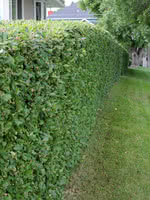Mon-Fri 9am - 5pm Mountain time
Peking Cotoneaster vs Common Purple Lilac
Cotoneaster acutifolia
Syringa vulgaris
NOT AVAILABLE THIS SEASON - MIGHT RETURN
Peking Cotoneaster is a medium-sized shrub that is well adapted to colder climates. Best suited for use as a hedge, Peking Cotoneaster has dark green foliage that turns a stunning reddish orange in the fall.
Hardy fruit guru, Bernie Nikolai (DBG Fruit Growers), has started to recommend grafting hardy pear varieties to Peking Cotoneaster after his experiences were successful and produced fruit faster than other rootstocks. Remember to leave some nurse limbs if you try this.
Common Purple Lilac is a popular lilac. This large shrub provides excellent privacy or wind protection in an attractive package.
Lilac flowers are pleasantly fragrant and add a beautiful lavender colour to your property. Common Purple Lilac is cold hardy, easy to grow, and can tolerate most soil types.
Some people alternate villosa and common purple lilacs to create the impression that the hedge is in flower for almost a full month with the common purple flowering about 2 weeks sooner than the Villosa Lilac.
Peking Cotoneaster Quick Facts
Common Purple Lilac Quick Facts
In row spacing: 0.3 m (1.0 ft)
In row spacing: 0.9 m (3 ft)

